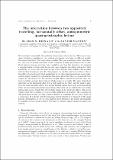The interaction between two oppositely travelling, horizontally offset, antisymmetric quasi-geostrophic hetons
Abstract
We investigate numerically the nonlinear interactions between hetons. Hetons are baroclinic structures consisting of two vortices of opposite sign lying at different depths. Hetons are long-lived. They most often translate (they can sometimes rotate) and therefore they can noticeably contribute to the transport of scalar properties in the oceans. Heton interactions can interrupt this translation and thus this transport, by inducing a reconfiguration of interacting hetons into more complex baroclinic multipoles. More specifically, we study here the general case of two hetons, which collide with an offset between their translation axes. For this purpose, we use the point vortex theory, the ellipsoidal vortex model and direct simulations in the three-dimensional quasi-geostrophic, contour surgery model. More specifically, this paper shows that there are in general three regimes for the interaction. For small horizontal offsets between the hetons, their vortices recombine as same-depth dipoles which escape at an angle. The angle depends in particular on the horizontal offset. It is a right angle for no offset, and the angle is shallower for small but finite offsets. The second limiting regime is for large horizontal offsets where the two hetons remain the same hetonic structures but are deflected by the weaker mutual interaction. Finally the intermediate regime is for moderate offsets. This is the regime where the formation of a meta-stable quadrupole is possible. The formation of this quadrupole greatly restrains transport. Indeed, it constrains the vortices to reside in a closed area. It is shown that the formation of such structures is enhanced by the quasi periodic deformation of the vortices. Indeed, these structures are nearly unobtainable for singular vortices (point vortices) but may be obtained using deformable, finite-core vortices.
Citation
Reinaud , J N & Carton , X 2016 , ' The interaction between two oppositely travelling, horizontally offset, antisymmetric quasi-geostrophic hetons ' , Journal of Fluid Mechanics , vol. 794 , pp. 409-443 . https://doi.org/10.1017/jfm.2016.171
Publication
Journal of Fluid Mechanics
Status
Peer reviewed
ISSN
0022-1120Type
Journal article
Collections
Items in the St Andrews Research Repository are protected by copyright, with all rights reserved, unless otherwise indicated.

